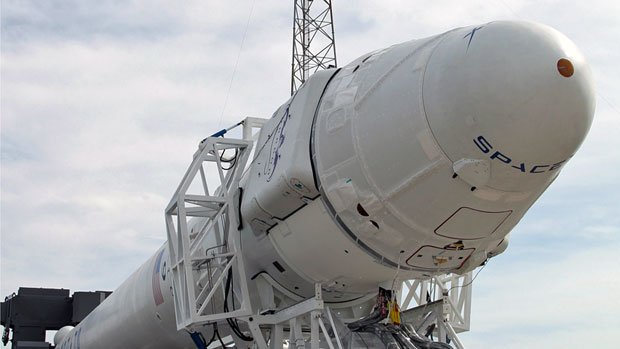
The launch of the American SpaceX’s Dragon re-supply mission to the International Space Station (ISS) has been delayed by at least three days.
The company was forced to abort the flight just as its Falcon rocket was about to leave the pad at Florida’s Cape Canaveral Air Force Station.
Early data indicated unusual pressure readings in one of the nine engine combustion chambers under the vehicle.
The company says it hopes to try again on Tuesday or Wednesday.
“We had a nominal countdown, right until about T-minus point-five-seconds,” explained SpaceX president Gwynne Shotwell.
“The engine controller noted high chamber pressure in engine five; software did what it was supposed to do – aborted engine five, and then we went through the remaining engine shut-down,” she told reporters.
“We need to lift off with all nine [engines], which is why we aborted. You can lose up to two engines and still make your mission, just not at lift-off.”

The next earliest launch opportunity is 03:44 EDT on Tuesday.
SpaceX is attempting to become the first private company to send a cargo craft to the ISS; and its Dragon ship, which sits atop the Falcon rocket, has been loaded with half a ton of food and spares for the purpose.
Such unmanned freighter missions have traditionally been performed by government-owned vehicles. But by buying in this service, NASA aims to save money that can then be spent on exploration missions far beyond Earth, to asteroids and Mars.
Both SpaceX and another private firm, Orbital Sciences Corp, have been given billion-dollar contracts by NASA to keep the space station stocked with supplies. Orbital expects to make its first visit to the international outpost with its Antares rocket and Cygnus capsule system later this year.
SpaceX’s mission – when it does eventually get under way – will be the final demonstration of its freight service. If all the mission goals are met to NASA’s satisfaction, the company’s $1.6 billion re-supply contract with the agency will kick in.
SpaceX wants eventually also to ferry astronauts to and from the ISS.
To that end, Dragon has been designed from the outset to carry people; and under another NASA programme, the company is working to develop the onboard life-support and safety systems that would make manned flights feasible.
Following the retirement of the shuttles last year, America has had no means of launching its own astronauts into space – rides must be bought for them on Russian Soyuz rockets at more than $60 million per seat. SpaceX says Dragon could be ready to carry people in 2015 at a seat price of $20 million.
“In order for NASA to be able to afford any programme of exploration in the future given the fiscal realities of the government, it has to transition away from high-cost services that are procured by and for the government into shared-use services that are competitively sourced,” observed Jeff Greason, the president of XCOR Aerospace and a leading proponent of commercial space activity.